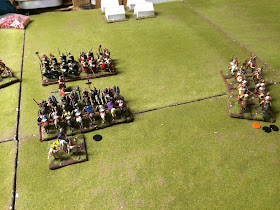 The Scenario
The Scenario
The Roman Army had 4x heavy divisions and 4 x light divisions:
Hastai / Principes x 6
Latin allies x 6
Skirmishers (javs) x 4
Italian cavalry x 2
Numidian cavalry x 1
The Punic army had 5 x heavy divisions and 5 x light divisions

African Veterans x 2
Punic citizerns x 4
Celts (slow) x 4
Skirmishers (javs or slings) x 6
Punic cavalry x 2
Numidian cavalry x 1
Flank march = 2 x Numidian javs, 1 x Numidian cavalry, 1 x Spanish LHI
Deployment
Our deployment followed the scenario map given above. The main adjustment from the core rules was to add an extra light command to enable the effective operation of the flanking force. The towns defences and the Roman camp were both purely for show and played no part in the scenario. |
| Roman right - the flanked side of the line |
 |
| Left of the Roman line |
 |
| Roman left flank - Latins guard the camp |
 |
| Roman fortified camp in the distance |
 |
| The Roman right |
Veterans are in the centre of the line so not really exploiting their manoeuvrability.
 |
| The right of the Punic line |
 |
| Punic left flank |
 |
| A long shot showing both sides |
 |
| The flankers, Spanish and Numidians |
The Battle
Both sides moved forward with their cavalry on the flanks and the Romans proceeded full steam ahead seeking to outdistance the flankers as quickly as possible. Knowing that he as at a disadvantage in the centre Hannibal advanced cautiously, mostly to deny the Romans too much space to out run the flankers.
On the Punic left there was a fairly long-running cavalry melee that eventually resulted in the destruction of the Punic cavalry.
 |
| Cavalry slug it out on the Punic left |
On the Punic right both sets of cavalry quickly came to blows. After a few rounds the Punic's Numidian allies were able to chase-off their opposite numbers and threaten the Latin's flanks. The early death of a Punic general accompanying the cavalry was a blow but somehow they mmanaged to hang until the end of game.
 |
| Cavalry combat on the Punic right - this would last all game |
So we come to the centre of the field where the heavy infantry combat took place. The initial charge to contact was a disappointing affair for the Carthaginians with lots of "1's" along the line meaning that the Celts lost their impetus and did little damage. However all was not lost as the flanking units had arrived in the Roman rear and charged-in.
 |
| The heavies get stuck in |
 |
| Flank marchers arrive in the Roman rear |
 |
| Romans open up a flank |
 |
| Carthaginians open their flank |
 Conclusion
Conclusion
Its hard to pin-point any specific errors made by Hannibal in this battle, but a few thoughts occur:- There were three 50/50 cavalry combats and the romans Managed to win three. This cost Hannibal 3 key units (inc the dead general).
- The flakers were nasty but not as nasty as they would have been if it was heavy troops. so the scenario was balanced in that respect.
- The Punic's dice were either poor or amazing, but the Romans got the luck when it counted most.
This now concludes the action in the Armati Punic Wars campaign for now. We'll be back in future with two more campaign for which we're painting madly; First Crusades and Successor states.

Nice to see a game with some terrain on, these Aramati games look a little odd to my eye being mainly on flat plains. Historically accurate no doubt, but odd looking.
ReplyDeleteI have a cunning plan for a future campaign with Rome or Carthage vs a variety of opponents where terrain will be more prominent. However for the Punic wars it was mostly fairly flat / open plains perhaps with some impassable terrain on one flank
ReplyDelete